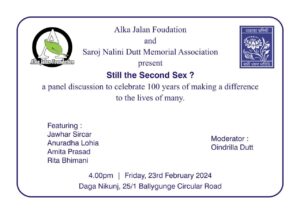 From the discussions so far, I have heard two challenges heading towards CSW 60: First, we won’t get far if we don’t implement the BPfA, CEDAW and the SDGs at national level. Second, the general public has no clue what that alphabet soup of UN documents means or why they are so important for the women’s movement. Truth is, that these are very familiar obstacles that have faced the feminist and women’s movements for more than 20 years. If you don’t believe me, please note this quote from the BPfA:
From the discussions so far, I have heard two challenges heading towards CSW 60: First, we won’t get far if we don’t implement the BPfA, CEDAW and the SDGs at national level. Second, the general public has no clue what that alphabet soup of UN documents means or why they are so important for the women’s movement. Truth is, that these are very familiar obstacles that have faced the feminist and women’s movements for more than 20 years. If you don’t believe me, please note this quote from the BPfA:
“The empowerment and autonomy of women and the improvement of women’s social, economic and political status is essential for the achievement of both transparent and accountable government and administration and sustainable development in all areas of life.” Our argument is pretty much the same today and the results are not much different.
For years, some of us have been desperately looking for new strategies—a new approach to this age-old problem that can help us to scale up and speed up progress. Today, I’m happy to report that the NGO CSW/NY Cities for CEDAW campaign as great potential to take us in that direction.
In 1998, San Francisco became the first municipality in the world to adopt a local ordinance reflecting the principles of the UN Convention on the Elimination of all forms of Discrimination against Women (CEDAW). I’d like to acknowledge Krishanti Dhamaraj and our peer leaders from San Francisco who pioneered this initiative. Between 1998 and 2013, other cities — including Los Angeles and Berkeley, as well as the State of Hawaii —enacted similar initiatives. In 2014 for Beijing plus 20, the NGO CSW/NY launched a national campaign to enroll a host of American cities—great and small. And at CSW 60 we plan to launch Cities for CEDAW as an international campaign.
The concept is simple: If we can weave women’s human rights into the sustainable development agenda in cities, we can scale up and speed up implementation of the 2030 agenda.
What have we learned so far?
- We must tap the great potential of women’s leadership in cities.
Women are increasingly leaders at the municipal level. For example, in Costa Rica, Belarus, Republic of Moldova, and Ukraine, there are more women councilors than men at local levels. The countries with the highest proportion of women mayors include Latvia (25%), Mauritius (40%), New Zealand (26%), and Serbia (26%)[1]. Still, women often do not pay close attention to local elections. With a successful campaign, we can mobilize voters–especially youth and women– in support of the BPfA, CEDAW and the SDGs.
- Working with city leaders can help bring men on board.
So far, the campaign has engaged more than 50 cities and counties across the U.S., earned commitments to CEDAW from more than 200 mayors. At CSW 59, three male mayors and Gavin Newsom, Lt. Governor of California sent video messages endorsing CEDAW and calling on other mayors to make women’s human rights central to city programs and services. Mayor Li of San Francisco used the CEDAW ordinance to end gender discrimination in the public works, fire and police departments.
3. Coalitions can be built around CEDAW
“Cities for CEDAW” campaigns are just starting in Cincinnati, Pittsburgh, Santa Monica, Sarasota and other cities. In New York City the strategy is to build coalitions of municipal constituencies from the bottom up [2] so leaders have reached down to the Borough level to start a “Boroughs for CEDAW” campaign. Two statewide coalitions have emerged in Oregon and North Carolina, while Orange and Miami-Dade Counties have focused on countywide ratification of CEDAW. Hearing of the US effort, the CEDAW experts who serve on the UN CEDAW committee encouraged us at this year’s informal briefing in Geneva to take this campaign to to the international stage. Early prospects include Nigeria, France, Trinidad/Tobago, India and Brazil.
4) Cities have the ability to innovate and measure rapid change, even when national governments cannot—or will not—take action.
Policy change that has long been stymied at the national level can be achieved at the local level. For example, the WHO has been calling for universal health coverage for years. Guess what? San Francisco has put that in place. How about gender budgeting? Last August, Mayor Garcetti issued an Executive Directive on CEDAW. All General Managers and Department Heads across all sectors are to submit a Gender Equity Action Plan by this February. We continually call for improved data—and that can happen in cities. This year, Los Angeles commissioned groundbreaking research on women’s employment that revealed gender gaps in hiring practices by race, economic status, and disability. The Leadership study will also help city officials make sure that marginalized women and girls are given more opportunities for social and political participation.
5) Innovative financing is possible
There are many lessons to be learned in cities about innovative financing and resource mobilization as many cities work closely with local foundations, individual philanthropists, the private sector, and small businesses. If successful, the Cities for CEDAW campaign will help to strengthen the finances of urban women’s bureaus and commissions and build their capacity to access national and international resources.
Looking ahead at the UN calendar for 2016, I have two recommendations:
First, for governments and the UN – We need a strong recommendation a higher priority for Goal 11 on sustainable cities and communities in the Agreed conclusions. Second, the feminist and women’s movement should help build momentum heading to Habitat III and the High Level Political Forum.
In conclusion, I would like to emphasize that if we don’t get it right in cities, we will surely fail on a global scale. In Qatar, Singapore, and South Korea, the majority of women and girls are city dwellers. By 2050, nearly 80% of the world’s women and girls will live in urban areas.[3] Furthermore, decisions made right now in cities is determining the fate of rural women’s livelihoods, food security, climate change, and the environment. We have an historic opportunity to demonstrate – in tangible and measurable ways—that enhancing women’s human rights is a practical approach to sustainable development and that the UN can help transform the lives of women and girls in developed as well as developing countries. The good news is that we are well on our way to sending that message—one city at a time.
____________
You are invited to an NGO CSW/NY parallel event on 17 March at 6:15, second floor at the Church Center that will launch the international campaign.
[1] The World’s Women 2010, United Nations, New York.
[2] The information presented here is a summary of reports submitted to the NGO CSW/NY up to October 15 2015. For more information on the cities engaged in the campaign, see: https://citiesforcedaw.wordpress.com/2014/06/05/welcome-to-the-cities-for-cedaw-weblog/ and https://www.facebook.com/cities4CEDAW/
[3] UN Conference of Parties, Outreach Issues, Warsaw, 2013, www.cop19.gov.pl.


